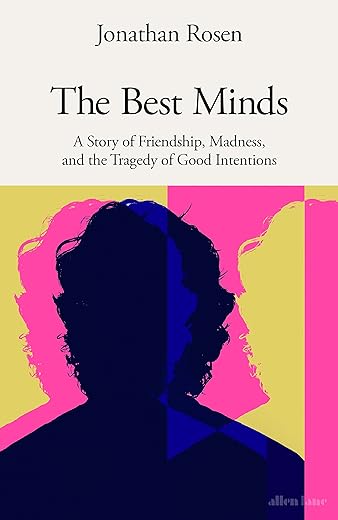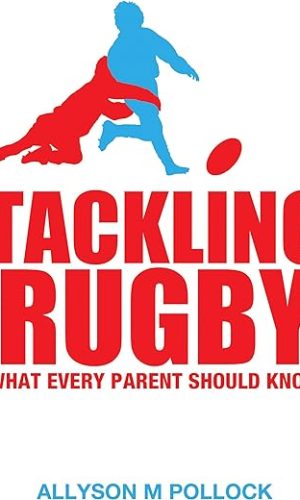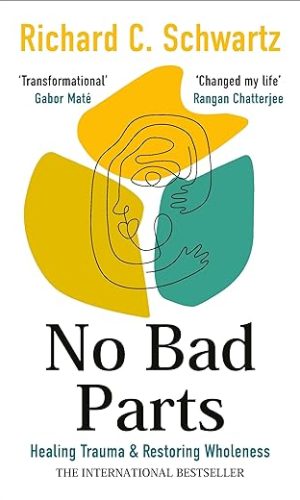The Best Minds: A Story of Friendship, Madness, and the Tragedy of Good Intentions
£17.90£28.50 (-37%)
‘Extraordinary… Magisterial… A remarkable meditation on friendship, success, madness and violence that refuses to oversimplify’ Guardian (Book of the Day)
‘The darkest of literary triumphs, and the most gripping of unbearable reads’ Telegraph (5 stars)
A novelist’s gripping investigation of the forces that led his childhood best friend from academic stardom to the psychiatric hospital where he has lived since killing the woman he loved
When the Rosens moved to New Rochelle, New York in 1973, Jonathan Rosen and Michael Laudor became inseparable. Both children of professors, the boys were best friends and fierce rivals who soon followed each other to Yale University.
Michael blazed through Yale in three years, graduating summa cum laude and landing a top-flight consulting job. Then one day, Jonathan received a devastating call: Michael had suffered a psychotic break and was in the locked ward of a psychiatric hospital.
Diagnosed with schizophrenia, Michael was still in hospital when he learned he’d been accepted to Yale Law School, and living in a halfway house when he decided, against all odds, to enroll. Still battling delusions, he managed to graduate, and after his triumphant story was featured in The New York Times, sold a memoir for a vast sum. Ron Howard bought film rights, completing the dream for Michael and his tirelessly supportive girlfriend Carrie, and Brad Pitt was set to star. But then Michael, in the grip of psychosis, committed a horrific act that made him a front-page story of an entirely different sort.
The Best Minds is Jonathan Rosen’s powerful account of an American tragedy, set in the final decades of the American century, an era that coincided with the emptying out of state mental hospitals. It is a story about the bonds of friendship, the price of delusion and the mystery of identity. Tender, funny, and harrowing by turns, The Best Minds is both a beautifully rendered coming of age story and an indictment of the profound neglect of mental illness in our society.
Read more
Additional information
| Publisher | Allen Lane (18 April 2023) |
|---|---|
| Language | English |
| Hardcover | 576 pages |
| ISBN-10 | 0241647444 |
| ISBN-13 | 978-0241647448 |
| Dimensions | 16.4 x 3.5 x 23.6 cm |










by green_life7
A tragedy but not relieved by Rosen’s good ‘humour.’ There comes a point where the reality of tragedy has to be faced for what it is, and not cast around for speculative explanations.
by Amazon Customer
Much of the book explores the changing policies and attitudes towards mental illness in the US, from deinstitutionalisation to today, as they evolve alongside the author’s childhood friend’s struggle with schizophrenia. Both the history and the personal narrative are fascinating, and I found both strands quite depressing.
by Lady Fancifull
Jonathan Rosen’s autobiographical/biographical account of his own childhood, and that of his childhood friend, a brilliant boy and man, seemingly destined for great things, but who had developing, finally lethal, and devastating, psychotic mental health, is a complex read.
Overlong, somewhat repetitive and overdetailed, this book explores, and is interesting in its exploration of the history of psychiatric treatment protocols, in the latter quarter of the twentieth century. The political landscape and the changing protocols towards treatment are gone into at depth. As is the devastating fallout of financial decisions which meant that a kindlier approach to the treatment of mental health than the stigma of the old asylum system, with people institutionalised and hopeless, has not worked. Asylums have been closed in favour of community mental health programmes, created with compassion and positive commitment. The reality on the ground however, needs capital and skilled, joined up care between overlapping sectors. Instead, seriously ill people (and this is of course also true in simpler health challenges) have been tossed out of hospitals offering 24 hour care and observation, far too quickly, and thrown back into the care of family, friends and neighbours. A community without the needed resources, and, in the case of serious mental health issues, often the family, friends and communities themselves find their own health, physical, mental and emotional, cracking and straining with the challenges of managing someone, however loved, who is no longer ‘themselves’
The antipsychiatry movement of the 60’s and 70’s, however well-meaning, must bear some of the blame. Rosen draws interesting parallels with what was happening in post-modernism, and the analysis of literary fiction, by luminaries such as Derrida, and a linking with those who say in an ‘insane’ society, madness is the sane response
No one can deny that much is deeply damaged in our world, but not every person out of their ‘right mind’ whatever that is, is a seer or a shaman (which is another view – that the ‘mad’ are in touch with real wisdom.
I had some nagging ethical concerns with this book. In some ways, I might have been less concerned had this book about Michael Laudor, Rosen’s one time best friend, and the object of Rosen’s envy, sometimes resentment, as well as hero-worship, been written by a writer and journalist (as Rosen is) without a prior connection to the subject.
Laudor who had a psychotic breakdown in his twenties, shortly after graduating at the highest level, from Yale, clawed his way back to fame and fortune as an inspirer of others at the edge of lawmaking, policy and fights for societal justice for the marginalised. He was commissioned to write his autobiography which was already, even in the writing, already set to be filmed, starring Brad Pitt. Laudor seemed to be on the cusp of even greater things, and was in a settled and loving relationship with a wonderful, intelligent and compassionate woman, herself doing great work with the marginalised. Unfortunately, a far more serious breakdown, this time right in the public eye, due to Laudor’s fame, led to him committing a horrific murder, and the end of everything his life had seemed to promise
I could not help somehow feeling uneasy that Rosen will of course be profiting his career and income by this recounting. I assume that Laudor’s family, whom he was so closely associated with, from the friendship between their two families, were consulted before this book was embarked upon
Was this review helpful?
by Dave from London
The resettlement of patients from the asylums to the community began in the 1950s with the introduction of antipsychotic drugs. It had nothing to do with the counterculture. The hopes that the introduction of antipsychotic drugs brought were often dashed when, for some patients, they proved ineffective or caused intolerable side effects. Jonathan Rosen tries to blame noncompliance for high profile crimes committed by care in the community patients suffering from schizophrenia, but often these crimes are accompanied by a history of drink and drug abuse and Michael Laudor, the subject of Rosen’s book, was no different. Though Rosen plays down the issue, he lets slip that, as a teenager, Laudor took to drink and drugs like a duck to water. But Rosen is quick to try and discredit Ken Kesey’s ‘One Flew Over the Cuckoo’s Nest’ citing his drug use as a reason. From ‘The Best Minds’ by Jonathan Rosen,
‘It turned out that even ‘One Flew Over the Cuckoo’s Nest’ had less to do with mental illness than with the CIA’s secret drug testing project, which Ken Kesey had participated in while writing the novel the movie was based on. Kesey liked the LSD he was given so much that he got a job in the hospital on the psych ward of the veteran’s hospital where the testing took place, helping himself to to samples while working as a janitor on the night shift. He mapped out his novel wandering the halls in a drugged-out spirit of sympathetic fellowship, encountering psychiatric patients who appeared through a scrim of government sponsored acid trips, like versions of himself in need only of liberation.’
Rick Dodgson tells us a slightly different story in his Ken Kesey biography, ‘It’s All a Kind of Magic: The Young Ken Kesey’. Dodgson says that Kesey only occasionally took drugs at work. He was on the night shift working Monday to Friday, from midnight to 8 a.m. All he had to do was ‘a little mopping and buffing, check the wards every forty-five minutes with a flashlight, be coherent to the night nurse stopping by on her hourly rounds . . and talk to the sleepless nuts. That’s when I did most of my writing’. He spent about six hours a night behind a typewriter in the nurses’ office, writing in situ. ‘One Flew Over the Cuckoo’s Nest’ reads as a well observed straightforward narrative. Throughout his life Ken Kesey told interviewers that McMurphy was not based on him. The film of ‘One Flew Over the Cuckoo’s Nest’ swept the board at the Academy Awards winning five Oscars. Only two other films have ever done this.
Right to the end of ‘The Best Minds’ Jonathan Rosen is determined to blame the counterculture, even though he admits to including just two books about Allen Ginsberg and the Beats; a memoir by Bob Rosenthal, ‘that stands in for many others’, and a collection of letters between Allen Ginsberg and his father Louis.
Fortunately, the similarly titled ‘Best Minds: How Allen Ginsberg Made Revolutionary Poetry from Madness’ by Stevan M. Weine was published in March of this year. His book examines the constructive relationship Allen Ginsberg had with the arts friendly regime at New York State Psychiatric Institute, where he was an inmate in 1949. There, Dr Nolan D C Lewis, the first psychiatrist in America to take patients’ artwork seriously, had supported Margaret Naumburg in establishing the first arts friendly therapy programme in America at a psychiatric hospital. Being encouraged to paint and write helped Allen Ginsberg talk about his symptoms and problems to his psychologists and he was discharged without having to endure any of the now discredited physical treatments of the era.
In his book ‘The Best Minds’ Michael Rosen is better at writing from experience and observation than he is writing from research. Though he is right to want answers, he makes no attempt to differentiate between the harmless schizophrenic, so often the victim in the community, and the criminally insane. Schizophrenic patients in the community have enough problems negotiating the day without having to endure the burden of the reputation of a very few high-profile offenders.